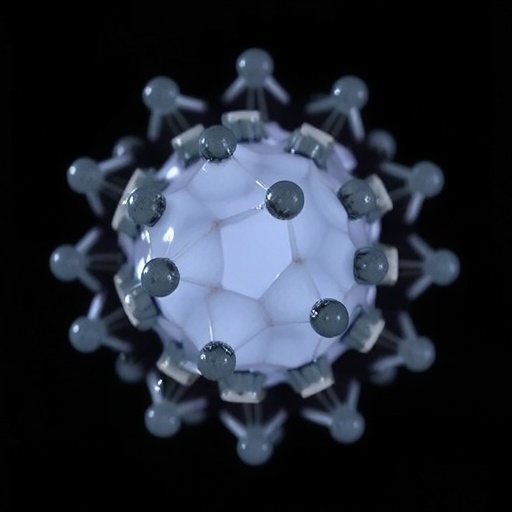In the realm of organic chemistry, the synthesis of complex molecules often necessitates innovative approaches that minimize the utilization of heavy metals due to their environmental and health concerns. Researchers are persistently seeking alternative methodologies that can achieve the desired synthetic outcomes while adhering to greener practices. A promising advancement in this field has emerged from research conducted by Xie, Xu, Zhu, and their colleagues, who have made groundbreaking strides in the metal-free synthesis of phosphoramidates.
Phosphoramidates are critical intermediates in the synthesis of various bioactive compounds, including pharmaceuticals and agrochemicals. Their versatile applications are matched by the challenge of synthesizing them efficiently and cost-effectively. In this context, the recent study presents an inspiring method of creating phosphoramidates through a metal-free process that leverages the catalytic properties of iodide ions (I−). This innovative strategy not only offers a sustainable alternative to traditional methods that often involve cumbersome reagents but also opens new pathways for organic synthesis.
The researchers carefully designed their experiments to explore the oxidative coupling reactions of anilines and amines with H-phosphonates, reacting under mild conditions to yield phosphoramidates. By using iodide ions as the catalyst, they successfully accomplished this coupling reaction without the need for any metal-based components. This metal-free strategy is a significant leap forward in reducing environmental impacts, thereby aligning with the growing demand for greener chemical processes.
One of the standout features of this research is its approach to understanding the mechanism underlying the oxidative coupling process. The authors meticulously investigated how iodide ions facilitate the formation of reactive intermediates, which ultimately lead to the desired product. Their studies reveal that the presence of I− enhances the electron transfer process, thereby promoting the oxidative pathway required for an effective coupling reaction. This mechanistic insight not only solidifies the role of iodide as a catalyst but also sets the stage for further investigations into other potential metal-free reactions.
The scientists harnessed the power of H-phosphonates as the phosphonylating agents in this synthesis, marking a departure from traditional phosphorous sources. H-phosphonates have often been overlooked in favor of more complex reagents, but this study showcases their utility, particularly in metal-free conditions. The study details how these compounds can be reacted with a range of anilines and amines, highlighting the broad applicability of this method across different substrates, which expands the toolkit for synthetic organic chemists.
The results are significant; the researchers reported yields of phosphorylated products that compete with those obtained through conventional methods while minimizing the environmental footprint associated with heavy metal catalysts. Furthermore, this research sheds light on the inherent reactivity of iodide ions, which in alternative substrates can facilitate various transformations that may be harnessed for further synthetic innovation.
With the advent of this metal-free strategy, the implications for pharmaceutical research and development are profound. Phosphoramidates play a pivotal role in drug design, and an efficient synthetic route could expedite the development of novel therapeutics aimed at a myriad of health challenges. The availability of a greener pathway for their synthesis could potentially transform how chemists approach the drug discovery process, leading to more sustainable practices in pharmaceutical manufacturing.
As the scientific community embraces the findings of this study, it encourages a paradigm shift towards sustainable chemistry. The paper serves as an inspiration for other researchers to explore similarly innovative methods that comply with environmental standards while still achieving high levels of efficiency and product specificity. The potential applications of this method extend beyond just phosphoramidates, inviting chemists to consider how iodide-catalyzed reactions could be utilized in other areas of organic synthesis.
The implications of this research stretch beyond the confines of the laboratory. As industries around the globe are increasingly pressured to adopt sustainable practices, methods like the one presented by Xie and colleagues could redefine how chemical manufacturing is approached. This transformation is critical as society grapples with the realities of climate change and environmental degradation. The advancements made in this study exemplify how chemistry can adapt and innovate to meet contemporary challenges, paving the way for eco-friendlier commercial production of vital chemical entities.
In conclusion, Xie, Xu, Zhu, and their team have made significant contributions to the field of organic synthesis through their innovative metal-free methodology for synthesizing phosphoramidates. Their work not only fosters a deeper understanding of the chemical processes at hand but also actively contributes to the movement towards more sustainable practices in chemistry. As researchers build upon this foundation, the future of organic synthesis may well lie in the adoption of similar green chemistry principles, ensuring that the field remains both innovative and responsible.
This recent breakthrough represents a beacon of hope for scientists aspiring to marry efficiency with sustainability. As further studies emerge that expand the usage of metal-free catalysts, the scientific community may witness a revolution in various chemical processes. The marriage of creativity, rigorous research, and environmental stewardship may just prove to be the formula needed to shape the future landscape of synthetic chemistry.
Subject of Research: Metal-free synthesis of phosphoramidates via I−-catalyzed oxidative coupling.
Article Title: A metal-free synthesis of phosphoramidates via I−-catalyzed oxidative coupling of anilines/amines with H-phosphonates.
Article References: Xie, M., Xu, H., Zhu, L. et al. A metal-free synthesis of phosphoramidates via I−-catalyzed oxidative coupling of anilines/amines with H-phosphonates. Mol Divers (2025). https://doi.org/10.1007/s11030-025-11327-y
Image Credits: AI Generated
DOI:
Keywords: Phosphoramidates, metal-free synthesis, oxidative coupling, iodide catalysis, organic chemistry, sustainable practices, H-phosphonates.




